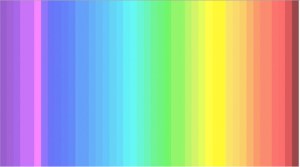Last week, everyone was talking about the blue/black or white/gold dress.
However, many people still couldn’t grasp why they saw the dress different than others.
An expert in neuromarketing created a post on LinkedIn explaining the basics of vision.
In the article, she posted a color spectrum similar to the one below.
(Click on the image to make it appear larger.)
Readers were asked to count how many different colors they saw in the spectrum.
If you see less than 20 colors, you are like 25 percent of the population and dichromat.
Dichromats have two types of color receptors.
Derval says dichromats are likely to wear black, beige and blue.
If you see between 20 and 32 colors, you have three types of color receptors.
About 50 percent of the population are trichromats.
If you see between 33 and 39 colors, you are a tetrachromat and have four types of cones.
Derval says tetrachromats are irritated by the color yellow but are less likely to be tricked by the blue/black or white/gold dress, no matter the lighting.
Only about 25 percent of the population is tetrachromat.
In case you were wondering, there were 39 different colors in the test.
Some are critical of the test.
See a mistake? Report a typo here.

















































































































